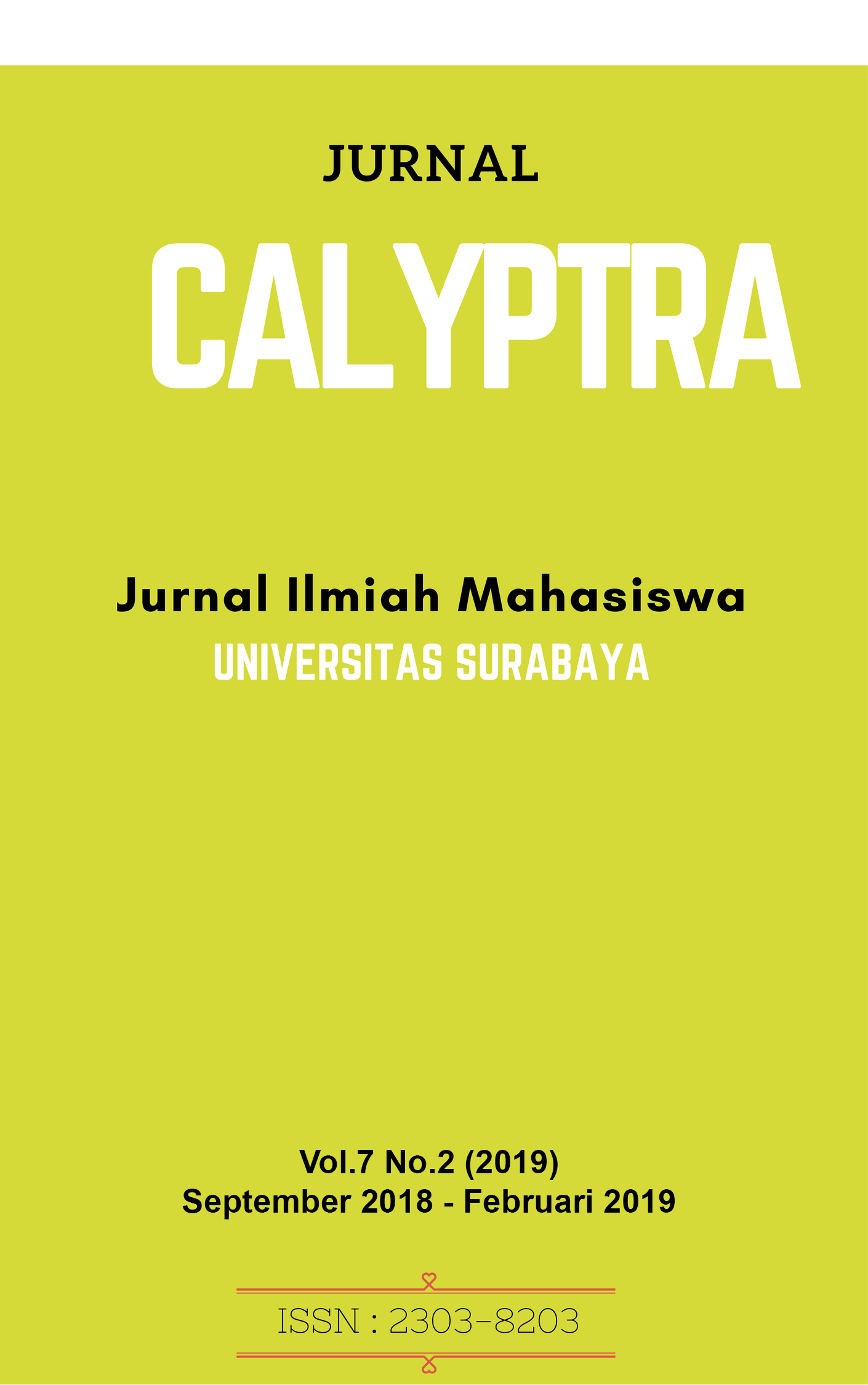HUBUNGAN ANTARA KONSEP DIRI DENGAN FUNGSI PSIKOLOGIS MAKE-UPPADA MASA EMERGING ADULTHOOD
 Abstract Views:
1231 times
Abstract Views:
1231 times
 PDF - FULL TEXT Downloads:
1833 times
PDF - FULL TEXT Downloads:
1833 times
Abstract
The period of adulthood emerging development starts from the age of 18-25 years. At this time individuals begin to be characterized by changes in development such as the development of reproductive systems, broader vision, and more can recognize the identity that is in him. Make-up or cosmetics have a psychological function that is make-up seduction function and camouflage make-up function. This study aims to determine the relationship between self-concept with the psychological function of make-up in the emerging adulthood. The method used in this study is quantitative explanative survey by spreading the questionnaire on the subject of 147 respondents. The sample of this research was done non-randomly with accidental quota sampling technique. Criteria subjects aged 18-25 years who use make-up 2 times in everyday life and minimal use 3 types of makeup that is, face powder, lipstick, BB cream. The hypothesis in this study was tested by Spearman Corellation technique. The results of this study showed no relationship between self-concept with the psychological function of make-up (r = 0,017; p = 0,417). In terms of the psychological function of make-up, there were 39 subjects (26.5%) classified as seduction, 84 subjects (57.1%) were classified as camouflage-seduction, 24 subjects (16.3%) were classified as camouflage. The subject of this study did not use the make-up function as the basis for the use of make-up. This is because the subject is accepted in the social environment in a positive way, making the subjectremains positive and confident even when not using make-up.
Downloads
References
Allisa, S. (2016, Juni). Produk kosmetik local, industry andalan Indonesia di 2019. Retrieved Juni 16, 2016, dari http://m.detik.com/wolipop/read/2016/06/16/071022/3234515/234/produk
-kosmetik-lokal-industri-andalan-indonesia-di-2019.
Arnett, J. J. (2000). Emerging Adulthood: A Theory of Development From the Late Teens Through the Twenties.Journal Vol. 55. No. 5. 469-480. American Psychological Association. Inc.
Aswar, S. (2003). Reliabilitas dan Validitas. Yogyakarta: Pustaka Pelajar. Aswar, S. (2012). Penyusunan Skala Psikologi. Yogyakarta: Pustaka Pelajar.
Brinegar, K., Weddle, Elyse. (2014). The Correlation Between Makeup Usage and Self-Esteem.PSY 344 Sosial Psychology. Hanover College.
Burns, R.B. (1993). Konsep Diri: Teori, pengukuran, perkembangan dan perilaku. Jakarta: Arcan.
Cci-indonesia. (n.d.).Perkembangan industri kosmetik di Indonesia, 2010-2015. Retrieved Juni, 17, 2017, diunduh dari http://cci- indonesia.com/2016/06/17/perkembangan-pasar-industri-kosmetik-di- indonesia-2010-2015.
Congadi, Y. (2010). Profil kepribadian ditinjau dari fungsi make-up pada sales promotion girls (SPG) make-up.Skripsi tidak diterbitkan, Fakultas Psikologi Universitas Surabaya, Surabaya.
Desmita. (2005). Psikologi Perkembangan. Bandung: PT Remaja Rosdakarya. Dewi, A. (2013, September). Pasar kosmetik di Indonesia masih menjanjikan.
Retrieved September, 24, 2013, diunduh dari http://industri.bisnis.com/read/20130924/12/164964/pasar-kosmetik-di- indonesia-masih-menjanjikan.
Ferani, A. A., Karini, S. M., Nugroho, A. A. (2015). Hubungan antara citra tubuh dan konsep diri dengan motivasi bertato pada wanita di Surakarta. Program Studi Psikologi, Fakultas Kedokteran, Universitas Sebelas Maret.
Handayani, Y. T. (2012). Self esteem dan fungsi psikologis make up pada mahasiswi fakultas psikologi. Skripsi, tidak diterbitkan, Fakultas Psikologi, Universitas Surabaya, Surabaya.
Heru, S. (2012). Dampak Sosial Alih Fungsi Lahan Terhadap Pola Kehidupan Masyarakat Desa Serang Kecamatan Karangreja Kabupaten Purbalingga. Program Studi Pendidikan Sosiologi, Fakultas Ilmu Sosial, Universitas Negeri Yogyakarta. Yogyakarta.
Hurlock, E. B. (1996). Psikologi Perkembangan: Suatu Pendekatan Sepanjang Rentang Kehidupan.Jakarta: Erlangga.
Hurlock, E. B. (1997). Psikologi Perkembangan Suatu pendekatan rentang kehidupan. Edisi kelima. Jakarta: Erlangga.
Hurlock, E. B. (1983). Personality Development. New York: McGraw-Hill, Inc. Irma. (2016).Pengaruh Ketergantungan Make Up terhadap Kepercayaan Diri Mahasiswi IAIN Antasari Banjarmasin.Fakultas Ushulludin dan Humaniora, Universitas Institut Agama Islam Negeri Antasari Banjarmasin, Banjarmasin.
Korichi, R., Pelle-de-Queral, D., Gazano, G., & Aubert, A. (2008).Why women use makeup: Implication of psychological traits in makeup functions. J. Cosmet. Sci., 59, 127-137.
Kuntjojo. (2009). Metodologi Penelitian. Kediri. Diunduh dari https://ebekunt.files.wordpress.com/2009/04/metodologi-penelitian.pdf
Krillia, S. P. (2016). Pengaruh tingkat penerimaan diri dan gender role terhadap intensi menggunakan make up. Fakultas Psikologi, Universitas Islam Negeri Maulana Malik Ibrahim Malang, Malang.
Maqassary, A. A. (2014). Ciri-ciri kepercayaan diri. E-journal psikologi.
Marsh, W. H., Richards, E. G. (1987). The Tennessee Self Concept Scale: Reliability, Internal Structure, and Construct Validity.
Muliyawan, D., Suriana, N. (2013). A-z tentang kosmetik. Jakarta: PT Elex Media Komputindo.
Pratiwi, R. A., Yusuf, M., Lilik, S. (2008).Hubungan antara konsep diri dan konformitas dengan perilaku merokok remaja. Program Studi Psikologi, Fakultas Kedokteran, Universitas Sebelas Maret.
Respati, W. S., Yulianto, A., Widiana, N. (2013). Perbedaan konsep diri antara remaja akhir yang mempresepsikan pola asuh orang tua authoritarian, permissive dan authoritative. Fakultas Psikologi. Universitas Indonusa Esa Unggul, Jakarta.Journal Psikologi, Vol. 4 No. 2.
Scott, S. (2007). Influence of cosmetic on the confidence of college women: An exploratory study. Diunduh dari http://psych.hanover.edu/research/thesis07/scottpaper.pdf.
Siaputra, B., Natalya, L. (2016). Pengukuran Psikologi: Teori & Praktek. Surabaya.
Silverio, Lauren. (2010). Makeup’s Effects on Self-Perception. OTS Master's Level Projects & Papers. Paper 49. Faculty of the Department of Occupational and Technical Studies, Old Dominion Univesity.
Syamsuddin. (2011).Hubungan konsep diri dengan kecemasan pada remaja putri di smp negeri 4 depok. Fakultas Ilmu Kesehatan, Universitas Yogyakarta, Yogyakarta. Tranggono, R. I., Latifah, F. (2007). Buku Pegangan Ilmu Pengetahuan Kosmetik. Jakarta: PT Gramedia Pustaka Utama.
Universitas Surabaya. (n.d.). Seminar dan Beauty Class Fungsi Psikologis Make- Up: Ber Make-Up Untuk Seduction, Bukan Camouflage. Retrieved Mei 30, 2017, diunduh dari http://www.ubaya.ac.id/2014/content/news_detail/1996/seminar-dan- Beauty-Class-Fungsi-Psikologis-Make-Up--Ber-Make-Up-Untuk- Seduction--Bukan-Camouflage.html
Weaver, R. (2012). The Connection Between Makeup and Mental Health. Retrived Februari 27, 2016, diunduh dari http://www.renfrew.org/newsevent/news/barefacedandbeautiful.html
Wiranata, C. D. (2016). Hubungan antara self esteem dan fungsi psikologis make up pada model. Skripsi, tidak diterbitkan, Fakultas Psikologi, Universitas Surabaya, Surabaya.
- Articles published in CALYPTRA are licensed under a Creative Commons Attribution-ShareAlike 4.0 International license. You are free to copy, transform, or redistribute articles for any lawful purpose in any medium, provided you give appropriate credit to the original author(s) and the journal, link to the license, indicate if changes were made, and redistribute any derivative work under the same license.
- Copyright on articles is retained by the respective author(s), without restrictions. A non-exclusive license is granted to CALYPTRA to publish the article and identify itself as its original publisher, along with the commercial right to include the article in a hardcopy issue for sale to libraries and individuals.
- By publishing in CALYPTRA, authors grant any third party the right to use their article to the extent provided by the Creative Commons Attribution-ShareAlike 4.0 International license.



